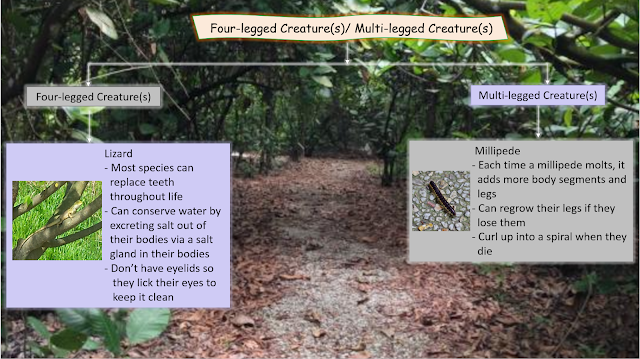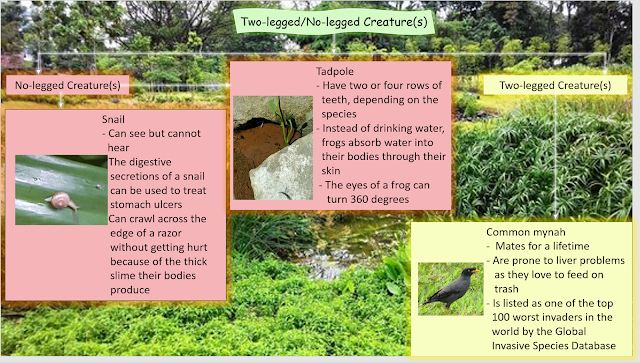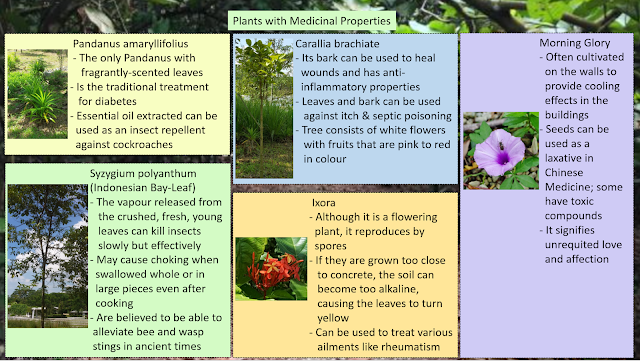Introduction:
JEG, the 5-hectare park, is known as the “green lungs” of CleanTech Park. JEG has four areas – Summit Forest, Wildlife Corridor, Stream Ravine and Freshwater Swamp Forest. JEG is full of biodiversity that consists of 139 species of flora and fauna, out of which six that are species of conservation interest. Besides being a home to those animals and plants, JEG also recycles renewable sources. For example, the eco pond at JEG helps to capture 65% of the rainwater run-off which will then be recycled for other non-portable uses in the park. In this way, JEG is helping to conserve water.
(Picture extracted from Google Images)
(Picture extracted from Google Images)
Group Reflection:
When we were at JEG, it was an eye-opener to us. We were pretty amazed to see different species of animals and plants, such as dragonflies, lizard, butterflies and many more! It was hard to capture a picture of a butterfly resting as they were flying about but after much attempts, we managed to! We also saw the features that showed the conservation efforts made by JEG, such as the Composting Station. Looking at those, we feel that these features are especially essential as they play a part in recycling renewable sources, which will be beneficial to all of us.
Part B: Grouping and Naming organisms
Part C: Man's impact on Jurong Eco Garden
Impact 1: Bringing nature closer to residents, workers in Jurong
Residents around the area often like to come to JEG. This is one of the impacts caused by man. Its nature attracts people and brings residents closer to nature. JEG also conserve trees and electricity, thereby resulting in a lesser wastage of natural resources. We get more oxygen when saving more trees and get to see more nature. When there are more trees, soil erosion can be prevented.
Impact 2: Eco-friendly area
JEG is the first eco-friendly park near industrial estates. It is near Nanyang Technological University and attracts people in the West to come for a stroll while enjoying the nature and scenery there.
https://www.youtube.com/watch?v=RXTvXMa_g5w
^News of JEG official opening
Impact 3: Saving resources for the future
JEG has many master plans for conserving resources such as reusing rainwater to flush toilets. Thus, we will have water for our future supplies. There are also automatic sensors where the lights are switched off when no one is present in the area, and vice versa.
Part D: Conservation efforts at Jurong Eco Garden/Conclusion
Conservation efforts: To sustain the area, JEG has been enhanced to turn into a lush forest, and there are also provisions for tree conservation. The park authorities at JEG have created a holistic storm water management system to collect rainwater for toilet flushing and irrigation. The water collected is then cleansed during conveyance by the biotopes put in place. It is then reused for non-portable uses like toilet flushing and irrigation of plants during dry periods.
Conclusion: I feel that what the park officials of Jurong Eco Garden have done is effective and are doing their most to safeguard the natural environment. Another way to conserve water is to build more freshwater swamps so that more fresh water can be collected for filtration, conserving a larger amount of water.
Credits and Acknowledgements:
Part A: Zhao Long
Part B: Wan Leng
Part C: Arunthathi
Part D: Paul
Photographer: Wan Leng (except for the first picture at the top)







No comments:
Post a Comment